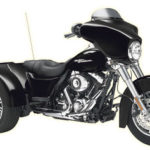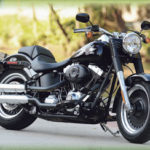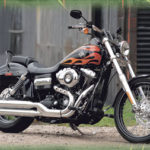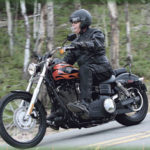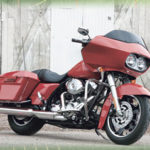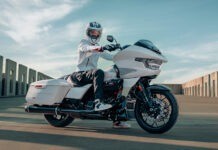Damn the torpedoes
Diving headlong into the ‘Dreamer Pool’
Denver, July 28–29—It’s been a tumultuous year for The Motor Company, one that’s seen widespread layoffs, turnovers in top management, talk of plant closures, plummeting sales and a concomitant steep reduction in unit sales projections, all capped by the most dismal quarterly financial results in a generation. A virtual perfect storm of upheaval and downsizing, it is, one whipped up by the same forces that have put the entire motorcycle industry on the ropes. It’s a state of affairs that would send lesser mortals augering down into an evil funk and groping for the Xanax. But not Bill Davidson. Irrepressibly upbeat, as always, Bill can’t help but see shiny ponies in all that horse manure.
The press has come to town for the 2010 model launch, arriving on the heels of the annual Harley-Davidson summer dealers meeting, and in recapping for our benefit what transpired during that meeting, Bill is frank in admitting that he had come fully braced to get an earful from worried and skeptical dealers. He got an earful, all right—but not of the sort he’d anticipated.
“The enthusiasm, the excitement, the passion, the dedication of our worldwide dealer network was at an all-time high,” he pronounces, adding, “I didn’t hear anything but positive comments.” You could, of course, dismiss those remarks as just the type of Pollyanna pep talk you’d expect under the circumstances, but there’s more to it than that. He’s in earnest. You can practically sense his goosebumps.
The Motor Company has a plan, you see, one that sees past the current crisis to a thriving future on the other side. In essence, it’s a plan that not only expands exponentially on the “outreach” campaign started a few years ago as a modest program to attract nontraditional buyers to the Bar & Shield, but also brings a renewed attention to the evolving character of that traditional base, and it brings with it a new script of buzzwords and concepts starting with the slogan “Every customer a custom.” Bill describes that slogan as the company’s new “battle cry,” and what it means is that Harley-Davidson is embarking on a hearts-and-minds crusade to identify and cater to the specific wants and needs of consumers, and get them connected “personally and emotionally” to the brand. And they’re not just talking about taking care of their current following. They’re talking about reaching out to an entire “multi-generational” population of potential Harley enthusiasts, a population they see as numbering 15 million people—a population they have dubbed the “Dreamer Pool.”
To canvass that vast audience as well as to anticipate the needs of the current graying base, The Motor Company has broken the field down into a bell curve of sorts, one ranged around the Baby Boom population “spike” that constitutes their core constituency. Arrayed around and on the upslope of that core are the outreach groups—the younger generation, minorities, and women. On the downside of the curve is the aging segment of the rider population—pretty much where the Boomers are all headed—if we’re lucky, that is.
Within this framework, the company has embarked on a sharpening of outreach and core focus, and the model development strategy and blueprint at this point is to offer a range of motorcycles, each carefully calculated and calibrated to appeal to one or another of those niches. That strategy can be seen at work in the new models introduced for 2010 and the models selected for elimination, and the desired result is that somewhere between the 883 Sportster Low and the Tri Glide there’s a model waiting for every dreamer. That’s the plan, anyway. We’ll let you figure out for yourself—and your kids and your parents, too—where you all fit in that constellation, and with that said, let’s take an overview of Harley-Davidson’s 2010 menu of enticements.
Sportster
The Sportster platform returns mostly unchanged for 2010, which should come as no surprise considering the 2009 mid-year introduction of two new models, the XR1200 and the Iron 883. Those models served to thoroughly flesh out the platform, adding a potent race-derived mount to the high end and a Dark Custom Sportster for the budget-minded on the entry level. One model, the 883 Custom, has been eliminated for 2010, having been essentially pre-empted by the Iron 883. That leaves the 883 Low, 1200 Low, and 1200 Custom to round out the collection. List prices on the bikes remain unchanged from 2009, starting at $6,999 for the 883 Low and topping out at $10,799 for the XR1200.
VRSC
The V-Rod family remains a close-knit group of the same three models offered last year. Again, there’s no real surprise there since last year’s splashy Muscle roll-out gave the platform all of the attention it could reasonably expect to get for awhile. Models include the V-Rod, Night Rod Special and Muscle, with the buy-in ranging from $14,999 to $17,199, same as last year.
Dyna
Before getting into the model details of the Dyna platform, we should point out the only fundamental mechanical modification made to those bikes as well as to all Big Twins for 2010, and that’s the replacement of the occasionally noisy straight-cut fifth speed cog in the Cruise Drive transmission with one that’s helical-cut. That’s a change you probably won’t notice on any of the unfaired models, but on those bikes with wind protection—the Ultra Classic, in particular—the difference is dramatic. Suffice to say that it effectively squelches the whining down below.
Back to the Dynas, the big news this year is the return of the Dyna Wide Glide after a short absence from the roster. This model was last offered in 2008, but only as a limited 105th Anniversary issue, and in the two years since it was a core model it has undergone a serious redesign and, aside from its basic chopperesque architecture, it now bears little resemblance to its polished precursors. It’s a darker, rawer approach to the form, and features black finishes on the wheel rims, wire sissy bar, headlamp shell, mirrors, fender struts, battery box and powertrain. It’s also equipped with a minimalist chopped rear fender, a side-mount license plate, and risers/drag bars in the place of the apehangers of yesteryear. The taillight’s been removed and all lighting and signaling operations are handled by the LED turn indicators. The suspension has been lowered front and back as well, and all of these elements follow the general styling trend of things in Milwaukee since the dawn of the Dark Custom culture—though the new Wide Glide is not referred to as a Dark Custom per se. It’s been given a new buzzword—the “Low Custom.” Another design detail of note is the raising of the front of the 4.7-gallon fuel tank (adopted from the Street Bob) by 0.75 inches, which adds to the rakish custom look of the machine. Perhaps the biggest departure from the previous Wide Glide is the new model’s sticker price, which at $14,499 is about $2,300 less than the 2007 model.
The other newsworthy development on the 2010 Dyna platform is the retirement of the Low Rider—though it will continue to be offered in Japan, where it’s proven Harley’s hottest seller. Don’t expect the retirement to last, though. It’s a safe bet that the model will undergo an extensive redesign along the lines of what happened to the Wide Glide, and be back in the game sometime in the near future. (We’re betting on a 2012 return for its 35th anniversary. We’re usually wrong about these things.)
The Dyna line-up for 2010 thus consists of the Wide Glide, Fat Bob, Street Bob, Super Glide, and Super Glide Custom with prices starting at $11,999—again, unchanged from 2009. See a pattern here?
Softail
The Softail stable sheds two mounts for 2010, with the Night Train being put to pasture, as well as the FXCW Rocker—though the FXCWC Rocker C remains. Joining the platform is the new Fat Boy Lo, a slammed black-and-satin chrome version of the 20-year-old and perennially popular Fat Boy model. Targeted principally at shorter riders of both genders (as well as Oakland Raider fans, perhaps), the Lo rides on suspension that has been lowered an appreciable 1.15 inches in the rear, giving the bike a seat height of 24.25 inches—the lowest of all H-D models. Further aiding the bike’s inseam-friendly objective, the seat is a slim and narrow affair that positions the operator closer to the controls than the traditional Fat Boy set-up. In keeping with the dark palette and retro-styling decree of the new Milwaukee order, this model gets blacked out from stem to stern, with the wheels, upper forks, struts, headers, air cleaner, headlamp, nacelle, and motor all sharing in the treatment. The Lo also receives the vintage-style half-moon floorboards first introduced on the Cross Bones, and later affixed to the Heritage Softail. They look so cool in every one of these applications that you can pretty much forgive their somewhat challenged cornering clearance.
The Softails for 2010 include the Fat Boy, Fat Boy Lo, Rocker C, Deluxe, Custom, and Cross Bones, with the Fat Boy the bargain at $15,999, and the Rocker C topping the list at $19,499.
Touring
Things get interesting on the Touring platform for 2010, starting with the discontinuance of the Road Glide—or at least the familiar dresser version of the model. In its place is the new Road Glide Custom which is equipped with the breed’s signature frame-mounted dual-headlight fairing, but that’s where the similarities end. And even that fairing, with its short dark windscreen and exposed headlamp fixture, is a change. You may remember it from last year’s CVO Road Glide. From there the lines blur nearly to the vanishing point between the Road Glide Custom and the 2010 Street Glide. Virtually identical in all particulars save the fairings, these two models comprise what’s called the “Hot Rod Bagger” subset of the Tourers. In that discipline, less is more, lower is better, and taller front tires rule. Both models have lowered rear suspension, 18-inch low-profile front tires, and they share the pre-existing Street Glide rear fender with its distinctive LED fender tip light bands and side filler panels. That super-clean fender has been made even more sanitary for 2010 with the elimination of the traditional taillight and the incorporation of all lighting and signaling duties into the turn signal housings and bracket. What the two Hot Rod Baggers also share is an excellent new two-into-one exhaust system that eliminates the left side muffler, pushing all the exhaust through a tapered right side pipe and giving the bikes a contemporary custom bagger look and attitude. It also has the advantage of letting you back the machine right to the curb and put it on its stand without fear of grounding a muffler.
And while we’re on the subject of blurring lines, the difference between the lavishly outfitted CVO Ultra and the basic Ultra Classic gets really fuzzy in 2010 with the introduction of the new FLHTK Ultra Classic Limited. This model is essentially a fully-accessorized version of its namesake and is being offered, we’re told, in response to the purchasing pattern of Ultra Classic buyers who, it seems, are wont to tack on optional equipment with more concern for copious amenities than bottom line economy. So The Motor Company laid it on thick with the Limited, outfitting the machine with virtually every bell, whistle and upgrade as standard equipment. That treatment starts with a Screamin’ Eagle 103-inch Twin Cam in place of the stock 96-incher, and goes on from there to add ABS, heated grips, Smart security, and a Tour Pak luggage rack. The full array of cockpit gauges are given titanium faces and white LED lighting. Like the CVO Ultra, the Limited does away with the chrome saddlebag guards for a cleaner profile. The cost of all those add-ons—and one take-off—is an additional $3,700 on top of the Ultra Classic’s $20,999 sticker price. Good deal.
One last development in the Touring line-up is, from our perspective, an unhappy one. The Electra Glide Standard—that marvelously utilitarian and economical dresser—has been discontinued for 2010. That’s strikes us as an odd choice for elimination, times being what they are. That leaves the Road King, Road King Classic, Street Glide, Electra Glide Classic, Ultra Classic and Ultra Classic Limited in the Touring fold with base prices starting at $16,999 for the Road King.
Trike
Harley-Davidson’s newest platform, the Trikes, came into being last year with the creation of the Tri Glide Ultra Classic—a creation facilitated by the fully-redesigned Touring chassis that allowed the bolt-on rear section to be removed and replaced with three-wheeled running gear. That model returns for 2010, and it’s been joined by a second model, the new Street Glide Trike. Like the Tri Glide, the Street Glide Trike is powered by a 103-inch motor, features a raked and extended front end that takes the troublesome three-wheel quirks out of the handling, and has a 4.3 cubic foot trunk rated at 50 pounds of capacity. Unlike the Tri Glide, the Street Glide Trike is without a Tour Pak, passenger backrest, and fairing lowers. That lowers the weight by nearly 70 pounds, and makes the machine a much sportier mount. Call it the Hot Rod Trike. The model’s base price is a reasonable $26,999. The Tri Glide goes for $29,999.


